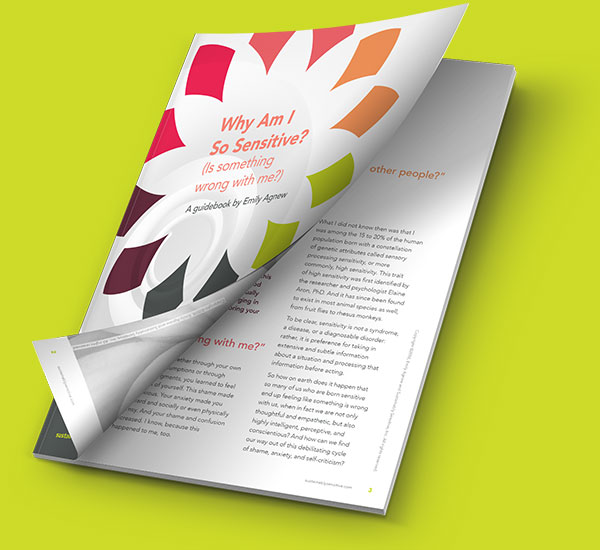Where does our HSP emotional intensity come from? And how can we keep ourselves emotionally regulated?
Dr. Elaine Aron, who first described the trait of high sensitivity, has identified four aspects of the trait that are shared by all HSPs: deep processing, overarousal, emotional intensity, and sensory sensitivity, or “DOES” for short.
Of the four, deep processing is the core aspect of our sensitivity. Our tendency towards overarousal is the natural result of our brains working overtime to try to process all the stimuli we take in from our environment as a result of our sensory sensitivity. Phew. So far, so good.
What about emotional intensity?
How does emotional intensity interlink with these three HSP aspects—the “D,” the “O,” and the “S” in “DOES?” Interestingly, if you’ve read Dr. Aron’s original and best-known book about the HSP trait, The Highly Sensitive Person, you may have noticed that she doesn’t use the phrase “emotional intensity” at all.
That’s because emotional intensity is so closely intertwined with overarousal that Dr. Aron felt it didn’t make sense to separate them. She changed her mind about that later, though, and gave each its own initial in the DOES model. In Psychotherapy and the Highly Sensitive Person* (abbreviated here as “P&THSP”), Dr. Aron explains the practical reasons for a somewhat arbitrary separation:
It is not easy to separate the two aspects of sensitivity that I have called overarousal due to overstimulation and emotional reactivity. Very little overarousal occurs apart from stimulation related to or caused by emotions. The exceptions are when overarousal is due to substances such as caffeine, physical exertion, or stimulation that is entirely physical, such as howling high winds or flood warnings, and when we have exceeded our cognitive capacity… Even these usually lead to emotion, however…
Further, stimulation comes from within as well as without, and much of that is due to the perception of bodily reactions resulting from emotions. However, I will continue to divide them, rather arbitrarily, into how to help [HSPs] deal with overstimulation due to outer stimuli and helping them regulate their affects in the way they wish. (P&THSP, p. 48-49)
Reading about emotional intensity may bring up intense emotions for you
As we continue to unpack Dr. Aron’s comments about emotional intensity, I have two requests of you:
1—Pause often. Ask yourself, “Does this feel familiar? How does this particular aspect of sensitivity show up in my own life?” Note any examples that come up.
2—Take time to reflect. Ask yourself, “How do I manage this aspect of my HSP trait? Am I pleased with the way I handle it? Or is it a challenge for me?”
By examining your reactions in this way as you read, you will be engaging in a key task for HSPs: reframing your life in terms of your sensitive trait. Please take care of yourself as needed as you engage in this reframing process: it may bring up intense reactions in you. As Dr Aron puts it,
Emotional overload is a particularly significant problem when discussing this material. [HSPs] may be flooded at any time with feelings of profound relief, gratitude, grief, or anger as they realize the implications of what they are learning…they may feel as if they are “coming out.” They have been keeping secret all these separate embarrassing problems without ever knowing the scope or the value of what they were hiding or that there were others like them. Having the complete picture can be quite profound. (P&THSP, p. 49)
Emotional intensity is a double-edged sword
Whether you’ve had a label for it or not, if you are highly sensitive, you know that you feel emotions intensely. You’ve also observed—or been told directly by other people—that you react more emotionally than they do.
Perhaps you were fortunate and got the message that your emotional intensity was a gift. It is. Like many powerful gifts, though, emotional intensity is a double-edged sword:
1—Our emotional intensity is closely related to our empathy for others. Having felt pain so keenly ourselves, we can perceptively sense what others might be feeling. On the other hand, this empathy can short-circuit our own self-care if we neglect our own needs for fear of hurting others.
2—We are gifted with vivid dreams that can give us deep insights or take us to exalted states of joy and clarity. On the other hand, we may suffer from nightmares. I’ve had dreams in which I soared above the Himalayas… and nightmares in which people were trying to kill me.
3—We can take profound pleasure and joy in the beauty of nature, art, and literature, and be deeply moved by the world in all its complexity. But we can also become overwhelmed by the seemingly endless war, suffering, environmental degradation and divisiveness we see around us.
Were you shamed for your emotional intensity?
Clearly, your emotional intensity brings challenges along with its gifts. Simply learning how to regulate our intense emotions takes skill and practice. Unfortunately, many sensitive people are dealing with an additional challenge: shame.
Did you grow up hearing you were “too emotional,” “too intense,” or “too sensitive?” This is incredibly painful. Your essential self is being called into question, which is bad enough. On top of that, the questioning itself makes the emotional reactivity even worse. You end up in a vicious cycle.
Shame feels awful. We all know that. However, to truly appreciate how devastating shame is for a sensitive child, we need to look more closely at its origins.
If you had healthy attachments with your primary caregivers, you learned how to regulate your emotions in those relationships. Affect regulation, as psychologists call it, is a skill, and we learn it from direct contact with our caregivers.
When you see a baby monkey and its mother hugging each other close, you are seeing the co-regulation process in action. The mother’s nervous system is calm, and the baby monkey tunes into that calmness to regulate its nervous system.
Now imagine a very different scenario in which the baby monkey is distressed, but the mother shrieks at it, or stalks away, leaving the baby alone. Now the poor baby monkey is struggling to handle its original distress, and the infinitely worse distress of conflict with its caregiver.
Attachment researchers call this a rupture. To a child, a rupture feels—and potentially is—life-threatening. Highly sensitive children feel that threat even more keenly. To avoid this terror, we learn to deny, minimize, or dissociate from our emotions. Shaming ourselves is a terrible but effective way of accomplishing all that.
Healing shame about your emotional intensity
The good news is, you can heal shame, and you can learn to stay regulated even while feeling intense emotions. You just have to learn how. “Affect regulation,” writes Dr. Aron, “does not mean victory over emotion:”
It requires a negotiated peace followed by a steady alliance. It is not victory to suppress or dissociate emotions to the point of having no idea what is happening inside. Rather, highly sensitive (people) need to become emotional experts…They can become experts easily, once they make it a goal. (P&THSP, p. 59)
We’ve seen the devastating effect shame has on a sensitive person. For this reason, your first goal in becoming an emotional expert is to develop an inner relationship with the part of you that believes your intense emotions are shameful, and with the part that does the shaming.
You begin to create these inner relationships by becoming aware of the inner shaming and acknowledging these two parts:
I’m sensing something in me that feels ashamed…it’s like a tight knot in my stomach…I’m acknowledging that is there.
I’m hearing a voice saying, “Ugh, you are such a drama queen. Calm down.” I’m acknowledging that too.
This deceptively simple step can have a dramatically calming effect on your nervous system. Remember the distressed baby monkey: the mother helps it calm down simply by holding it and letting it be. You are learning to offer this same calming, regulating acceptance to your inner parts.
From there, you can deepen the relationship with each part (and with any others that come up). This will calm and regulate your nervous system even more. Once you’ve addressed the outer layer of shame, you can respond directly to your intense emotions as they arise, using this same attitude of radical acceptance.
More ways to regulate your intense emotions
We’ve seen that creating a healthy inner relationship is key to regulating your emotions. Here’s a list of additional strategies Dr. Aron suggests (P&THSP, p. 60-67), to which I’ve added some of my own:
- Educate yourself about your trait (e.g. the difference between typical HSP caution vs chronic fearfulness)
- Reframe your view of your intense emotions (remembering the positive aspects)
- Learn to label and witness your emotions
- Understand the nature of anticipatory emotions (it is common, for example, for HSPs to grieve losses in advance)
- Develop healthy ways to express anger (which HSPs often fear)
- Treat your dreams as important messengers indicating your need for emotional expression
- Meditate daily with an intent to connect to something bigger than yourself
- Learn breath practices that regulate your nervous system
- Cultivate the kind of close relationships that help you regulate your emotions
- Plan proactively for big changes, which stimulate intense emotions for HSPs
With the right support, HSPs can learn to regulate our intense emotions and find peace and joy. This is true even if you had a challenging childhood and have struggled with anxiety, depression and overwhelm. Dr. Aron puts it this way (the italicized addition is mine):
Although greater emotional reactivity and the tendency to be overstimulated are innate and also even more problematic when [HSPs] had a painful childhood, many sensitive clients can change through psychotherapy [or other effective inner work] from being overaroused, anxious, and depressed to being mostly happy, optimistic, confident, and content. That is a wonderful fact. (P&THSP, p. 68)
In short, don’t hesitate to seek support if you need it. In the meantime, consider the strategies listed above. Which have worked for you? Which are new to you? And do you have your own strategies that aren’t listed here?
Image: ©2022 Emily Agnew
*Aron, Elaine (2010): Psychotherapy and the Highly Sensitive Person, New York: Routledge. Page references are from the paperback edition.




















My strategies to date are walking in the forest, swimming, snowshoeing in the forest, sitting amongst the trees preferably by a stream, and drawing with my non dominant hand.
I have been reading every book I can find at the library about forest bathing. The wonderful thing about this is that I don’t have to think about anything, I don’t have to reframe, I don’t have to talk ( all of which I find very overwhelming and can lead to overarousal).
I just have to sit with the trees. I enjoy walking, but some days I just sit. I have found a place that blocks out the cars and civilized world. The shinrin yoku guides of Japan suggest 4 hours at a time in the forest. I spent 2 hours one day this past week and I was actually so relaxed by the time I left, I was tired enough for a nap. And all I did was listen to the white noise of the stream, listen to the birds, and watch the wind in the trees! I keep reading that nature regulates our nervous systems, which in turn calm our emotions, by us just being in nature.
Another practice I just started is drawing with my non dominant hand. By no means have I ever considered myself a drawer, but there is a sense of accomplishment when drawing with my left hand. Nothing is planned, the lines aren’t perfect, but the results are surprising. Apparently drawing with our non dominant hand can reduce stress and anxiety.
Which leads me to your comment about HSP people fearing our expression of anger.
I read an article about anger and if I recall correctly it all starts with stress, then proceeds to anxiety, then possibly anger, and goes even higher to rage. When I approach my anger by looking at it as unresolved stress, unresolved anxiety then it isn’t as scary to try to sort out. It isn’t as overwhelming to sort out because as an HSP why would I enjoy conflict with myself when I don’t like conflict in general? The conflict is that I even have these emotions. Not that I am perfect, but as part of my HSP nature I like to keep the peace, I don’t like confrontation, I don’t like to raise my voice , I like to be efficient. …so if I have to address these concepts within myself because I was angry….this has always been very difficult to accomplish.
By calming my nervous system in advance on a daily basis as much as possible through exercise, and forest bathing hopefully I will be calmer to address the difficult emotions I experience within.
Thank you always for your blogs and variety of topics and for the opportunity for readers to respond so easily. Very much appreciated. Much great health to all HSPs.
Suzanne, you are most welcome. I agree, calming your nervous system in advance daily is an essential practice for HSPs…and it sounds like forest bathing is a perfect strategy for you to do that. It certainly is for me. Regarding anger, it’s also helpful to remember it is a red flag indicating you have an unmet need…but if we try to get our needs met in an angry way, it usually doesn’t go well. Hence the need to get to the needs underneath the anger.